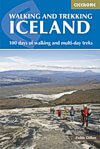ESC -
Iceland - Hvannadalshnúkur
, 2110m - InfoIntroduction :
Located in the southeast of Iceland, Hvannadalshnúkur is the highest of three peaks on the eroded crater rim of the Öræfajökull volcano. The volcano is mostly ice covered; the Vatnajökull glacier extends for approximately 8500 square Km from its bulk.
In July 2005 the National Land Survey of Iceland executed the most accurate survey that could be done at the time. The new measurement concluded that summit of Hvannadalshnúkur is 2110m above sea level. Previous to this measurement, a height of 2119m from a 1904 survey had been used in text books and atlases. However, because Hvannadalshnúkur is on a glacier its height varies within the year. The height is more after a heavy winter than in the autumn when the temperatures have been higher during the summer and melted the snow.
The Öræfajökull is an active volcano, the latest eruptions being in 1996, 1998, and 2004. On each occasion large scale destruction was cause by the vast snow melt. The largest recorded eruption occurred in 1362 and caused so much damage that the region was abandoned.
The mountain lies in the Vatnajökull National Park, a mountainous region of 1700 square km and worthy of exploration in itself. The campground in the National Park becomes the base camp for most of those wishing to make an ascent of Hvannadalshnúkur.
The first ascent of Hvannadalshnúkur was made on August 17th, 1891 by local guides Pall Jonsson, Thorlakur Thorlaksson and their British client Frederick W. W. Howell.
Currently mountain rescue is free in Iceland, but it would be more than wise to take out adequate insurance before departing. The emergency number in Iceland is 112. However mobile coverage is not perfect, GSM mobile phones (900MHz) only work in populated areas or by the main roads.
Routes :
There are two main routes to the summit, and though they are not technically challenging, you will need to be fit and ready for a 12 hour day (8 hours up, 4 hours down). Glacier travel is involved, and therefore there is a real danger from crevasses. So unless you are experience in crossing such terrain safely, it is recommended to join a guided group. Though admittedly this comes with its own perils. If one member of the group cannot make it, the whole group cannot make it.
The climbing season extends from April to September, with very long daylight hours and the best weather in July and August.
Check out the trip report at www.westcoastpeaks.com for an account of Arnt Flatmo and his friend Bjørn's successful summit without guides in August 2004.
Getting there and away :
Keflavik Airport, about 40 kilometres west of Iceland's capital Reykjavik. Once you have arrived, your best option will be to hire a car, but as with most things in Iceland this will be very expensive.
Take Highway 1 about 320 kilometers east to Skaftafell in the Vatnajökull National Park. Turn left at the sign for the Park and go about 2 kilometres to the Visitor Center and Campground. Be sure to visit to Iceland's Official Tourist website and heed their driving advice.
For a wider a more compeditively priced supplies purchase these on route to the Vatnajökull National Park.
Accommodation :
Hotels & Hostels : Check out the Icelandic Tourist Office website for hotel and hostel accomodation.
Camping : There is just the one camping ground in the vicinity, that at the Skaftafell in the Vatnajökull National Park.
Maps and Books :
| National Land Survey of Iceland map viewer. |
 The National Land Survey of Iceland produce mapping for the country, and there web site
www.lmi.is
is well worth taking a look at for some of the on-line mapping available, see above.
The National Land Survey of Iceland produce mapping for the country, and there web site
www.lmi.is
is well worth taking a look at for some of the on-line mapping available, see above.
 Paddy Dillon's "Walking and Trekking In Iceland" published by Cicerone Press (ISBN 9781852848057) in May 2015, second edition May 2019, includes a route description from Sandfell to Hvannadalshnúkur.
Paddy Dillon's "Walking and Trekking In Iceland" published by Cicerone Press (ISBN 9781852848057) in May 2015, second edition May 2019, includes a route description from Sandfell to Hvannadalshnúkur.
Useful Links :
www.icetourist.is is the official tourist website of Iceland.
www.mountainguide.is is a mountain guide companies in Iceland.
The Vatnajökull National Park website has great local information, hotels, restaurants, hiking etc.
You can read the latest UK government travel advise to Iceland at www.gov.uk.
For a weather forecast, check www.mountain-forecast.com.
